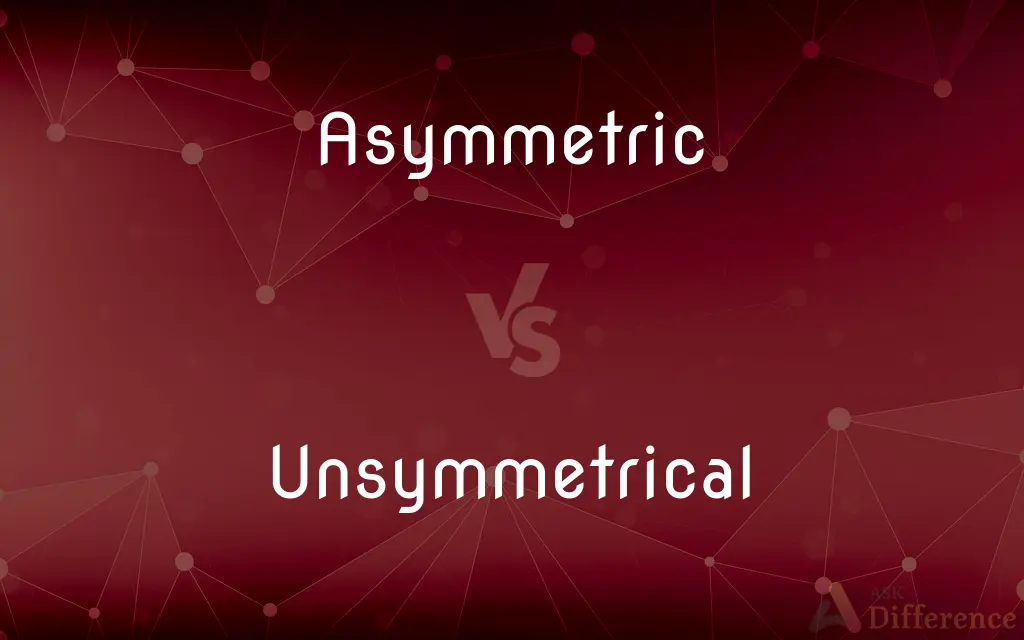Asymmetric vs. Unsymmetrical — What's the Difference?
By Fiza Rafique & Maham Liaqat — Updated on April 2, 2024
Asymmetric emphasizes lack of symmetry in broader contexts, including abstract or qualitative disparities, while unsymmetrical directly refers to the absence of symmetry in physical shapes or arrangements.

Difference Between Asymmetric and Unsymmetrical
Table of Contents
ADVERTISEMENT
Key Differences
Asymmetric often describes a broad range of imbalances or differences beyond physical shape, such as in mathematics, cryptography, or biology, where elements do not mirror each other across an axis or around a central point. On the other hand, unsymmetrical is more commonly used to describe physical objects or designs that lack symmetry in their shape or arrangement, focusing on visual or structural characteristics.
Asymmetric concepts are widely applied in various fields, indicating differences that are not necessarily related to physical forms. For example, asymmetric warfare refers to conflicts between parties of unequal strength, and asymmetric information describes situations where one party has more or better information than the other. Whereas unsymmetrical is often used in more specific contexts, such as in chemistry, to describe molecules that do not have symmetry in their structure, or in art and design to refer to objects or layouts that do not follow symmetrical patterns.
In terms of application, asymmetric is a term that finds relevance in discussions about balance and equality in abstract or conceptual terms, suggesting a broader interpretation that includes non-physical aspects. Whereas unsymmetrical strictly pertains to the visual or structural aspects of objects, making it more applicable in discussions about physical attributes or arrangements.
The distinction between asymmetric and unsymmetrical also reflects in their usage within specific disciplines. Asymmetric encryption in computer science, for instance, involves a pair of keys for encryption and decryption, highlighting a form of imbalance in the process. Unsymmetrical, however, might be used to describe the layout of a building or a garden that does not mirror itself on either side of a central axis, emphasizing physical layout rather than conceptual differences.
Despite their differences, both terms share a common ground in indicating the absence of symmetry, whether it's in the arrangement of parts, the balance of forces, or the equality of elements within a system. The choice between asymmetric and unsymmetrical often depends on the context and the specific nature of the imbalance or difference being described.
ADVERTISEMENT
Comparison Chart
Scope of Use
Broad, including abstract concepts
Primarily physical shapes or arrangements
Common Contexts
Cryptography, biology, warfare
Chemistry, art, design
Emphasis
Imbalances in a wide range of contexts
Lack of symmetry in physical form
Examples
Asymmetric information, asymmetric warfare
Unsymmetrical molecules, unsymmetrical design
Application
Often used in conceptual or abstract discussions
Used in discussions about physical attributes
Compare with Definitions
Asymmetric
Lacking symmetry in arrangement or form.
The asymmetric design of the building caught everyone's eye.
Unsymmetrical
Used to describe molecules in chemistry that do not have symmetrical shapes.
Unsymmetrical ethers are important in organic synthesis.
Asymmetric
In cryptography, involving keys that are not identical for encryption and decryption.
Asymmetric encryption secures communication, allowing only the intended recipient to decrypt the message.
Unsymmetrical
Not mirroring equally on both sides of an axis.
The artist's unsymmetrical composition created a dynamic balance in the artwork.
Asymmetric
Referring to imbalanced relationships or situations.
Asymmetric warfare involves combat between forces of unequal strength.
Unsymmetrical
Pertaining to objects or designs lacking symmetry.
The unsymmetrical pattern of the fabric made each piece unique.
Asymmetric
Related to non-equivalent or unequal elements in a comparison.
The debate highlighted the asymmetric levels of understanding between the participants.
Unsymmetrical
Relating to physical layouts or structures that are not symmetrical.
The garden's unsymmetrical layout added an element of surprise.
Asymmetric
Pertaining to uneven distribution or effects.
The policy had asymmetric impacts across different social groups.
Unsymmetrical
Concerned with the absence of visual balance in an arrangement.
The unsymmetrical arrangement of furniture in the room challenged traditional design norms.
Asymmetric
Having no balance or symmetry
An asymmetric design.
Unsymmetrical
Another term for asymmetrical
Asymmetric
Uneven in distribution.
Unsymmetrical
Asymmetric.
Asymmetric
Existing or occurring between two incommensurate entities, especially to the detriment of one.
Unsymmetrical
Not symmetrical.
Asymmetric
Characterized by an imbalance in power between two opponents in an armed conflict, especially one in which a weaker force uses unconventional means, such as guerilla or terrorist tactics
Asymmetric warfare.
Unsymmetrical
Wanting in symmetry, or due proportion pf parts.
Asymmetric
(Chemistry) Of or relating to a carbon atom having four different atoms or structural groups attached to it, resulting in an unbalanced spatial arrangement of atoms in a molecule, so that the molecule cannot be superimposed on its mirror image; chiral.
Unsymmetrical
Not symmetrical; being without symmetry, as the parts of a flower when similar parts are of different size and shape, or when the parts of successive circles differ in number. See Symmetry.
Asymmetric
Not symmetric.
An asymmetric shape
Asymmetric gameplay, where different players have different experiences
Unsymmetrical
Being without symmetry of chemical structure or relation; as, an unsymmetrical carbon atom.
Asymmetric
(cryptography) Not involving a mutual exchange of keys between the sender and receiver.
Unsymmetrical
Lacking symmetry
Asymmetric
(set theory) Of a relation R on a set S: having the property that for any two elements of S (not necessarily distinct), at least one is not related to the other via R.
Unsymmetrical
Having unsymmetrical parts or unequal dimensions or measurements
Asymmetric
Incommensurable.
Asymmetric
Not symmetrical; wanting proportion; esp., not bilaterally symmetrical.
Asymmetric
Characterized by asymmetry in the spatial arrangement or placement of parts or components
Common Curiosities
What is an example of an unsymmetrical object?
An unsymmetrical object could be a piece of modern art that does not mirror itself on any axis.
Can a situation be described as asymmetric?
Yes, situations like asymmetric warfare or asymmetric information highlight imbalances in power or knowledge.
What fields commonly use the term asymmetric?
Fields such as cryptography, biology, and economics frequently use the term to describe imbalances or disparities.
Why might a designer choose an unsymmetrical layout?
To create visual interest or to challenge traditional design norms with a unique aesthetic.
Is unsymmetrical only applicable to physical objects?
Primarily, yes. Unsymmetrical is mostly used to describe physical objects or designs that lack symmetry.
What makes a molecule unsymmetrical?
When the atoms in a molecule do not arrange themselves symmetrically around a central atom.
How does unsymmetrical design impact viewer perception?
It can create dynamic tension and interest, making the viewer engage more deeply with the design.
What does asymmetric mean?
Asymmetric refers to a lack of symmetry or balance, often used in broader contexts beyond just physical shapes.
How does asymmetric encryption work?
It uses a pair of keys, where one key encrypts the data, and a different key is required for decryption.
Can the terms asymmetric and unsymmetrical be used interchangeably?
While they share common ground in indicating a lack of symmetry, their usage depends on the context, with asymmetric having a broader application.
What is an asymmetric relationship?
It's a relationship where power or information is unevenly distributed between the parties involved.
How do asymmetric and unsymmetrical contribute to diversity in design?
They encourage exploring beyond conventional boundaries, fostering innovation and diversity in design and layout.
What challenges do unsymmetrical designs pose?
They can challenge traditional norms of balance and aesthetics, requiring more creativity in their execution.
Is asymmetry common in nature?
Yes, asymmetry can be found in many natural forms, from leaves to animal patterns.
Can asymmetry be seen as a positive feature?
In many cases, yes, as it can add uniqueness and character to both natural and human-made designs.
Share Your Discovery

Previous Comparison
Pity vs. Ruth
Next Comparison
Mucoid vs. MucopurulentAuthor Spotlight
Written by
Fiza RafiqueFiza Rafique is a skilled content writer at AskDifference.com, where she meticulously refines and enhances written pieces. Drawing from her vast editorial expertise, Fiza ensures clarity, accuracy, and precision in every article. Passionate about language, she continually seeks to elevate the quality of content for readers worldwide.
Co-written by
Maham Liaqat













































